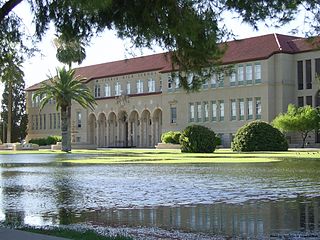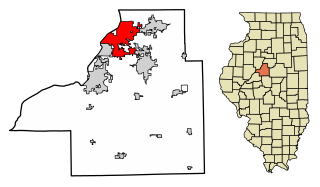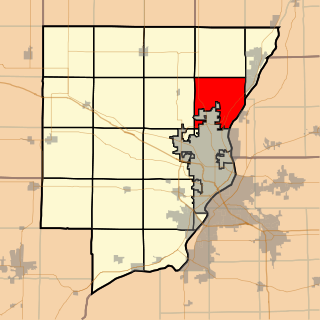
Peoria is a city in Maricopa and Yavapai counties in the state of Arizona. Most of the city is located in Maricopa County, while a portion in the north is in Yavapai County. It is a major suburb of Phoenix. As of the 2020 census, the population of Peoria was 190,985, up from 154,065 in 2010. It is currently the sixth-largest city in Arizona in land area and the ninth-largest in population. It was named after Peoria, Illinois. The word peoria is a corruption of the Miami-Illinois word for "prairie fire". It is the spring training home of the San Diego Padres and Seattle Mariners, who share the Peoria Sports Complex.

Champaign is a city in Champaign County, Illinois, United States. The population was 88,302 at the 2020 census. It is the tenth-most populous municipality in Illinois and the fourth most populous city in Illinois outside the Chicago metropolitan area. It is included in the Champaign–Urbana metropolitan area.

Canton is the largest city in Fulton County, Illinois, United States. The population was 14,704 at the 2010 census, down from 15,288 as of the 2000 census. The Canton Micropolitan Statistical Area covers all of Fulton County; it is in turn, part of the wider Peoria-Canton, IL Combined Statistical Area (CSA).

Chillicothe is a city on the Illinois River in Peoria County, Illinois, United States. The population was 6,097 at the 2010 census. Chillicothe is just north of the city of Peoria and is part of the Peoria Metropolitan Statistical Area.

Peoria is the county seat of Peoria County, Illinois, United States, and the largest city on the Illinois River. As of the 2020 census, the city had a population of 113,150. It is the principal city of the Peoria Metropolitan Area in Central Illinois, consisting of the counties of Fulton, Marshall, Peoria, Stark, Tazewell, and Woodford, which had a population of 402,391 in 2020.

East Peoria is a city in Tazewell County, Illinois, United States. The population was 23,402 at the 2010 census. East Peoria is a suburb of Peoria and is part of the Peoria, Illinois Metropolitan Statistical Area, located across the Illinois River from downtown Peoria. It is home to many Caterpillar Inc. facilities.

The Champaign–Urbana metropolitan area, also known as Champaign–Urbana and Urbana–Champaign as well as Chambana (colloquially), is a metropolitan area in east-central Illinois. As defined by the Office of Management and Budget (OMB), the metropolitan area has a population of 222,538 as of the 2020 U.S. Census, which ranks it as the 207th largest metropolitan statistical area in the U.S. The area is anchored by the principal cities of Champaign and Urbana, and is home to the University of Illinois Urbana-Champaign, the flagship campus of the University of Illinois system.

Robertson Memorial Field House was a multi-purpose arena on the Bradley University campus in Peoria, Illinois. The arena, built inside two surplus World War II airplane hangars in 1949 for $400,000, had a 3-foot raised floor as its sports court and event stage.

The Detroit Masonic Temple is the world's largest Masonic Temple. Located in the Cass Corridor of Detroit, Michigan, at 500 Temple Street, the building serves as a home to various masonic organizations including the York Rite Sovereign College of North America. The building contains a variety of public spaces including three theaters, three ballrooms and banquet halls, and a 160 by 100 feet clear-span drill hall.

Medina Township is located North of Peoria, in Peoria County, Illinois, and in the Illinois River Valley. As of the 2010 census, its population was 12,564 and it contained 4,993 housing units.

The Scottish Rite Cathedral in Indianapolis, Indiana is a historic building designed by architect George F. Schreiber and located in downtown Indianapolis. It is owned by the Valley of Indianapolis Scottish Rite, an affiliated body of Freemasonry. It was built between 1927 and 1929 at the cost of $2.5 million. Every dimension of the structure is evenly divisible by three, with many also being divisible by 33.
Scottish Rite Cathedral and Scottish Rite Temple are names commonly applied to buildings used by Ancient and Accepted Scottish Rite, a body associated with Freemasonry. It may refer to any of a number of specific buildings, including:

The Old National Centre, formerly known as the Murat Shrine Temple and the Murat Shrine Center, is located at North and New Jersey streets in Indianapolis, Indiana, and is owned by the Murat Shriners of the Ancient Arabic Order of the Nobles of the Mystic Shrine. The theater portion of the building is now known as the Murat Theatre at Old National Centre or simply the Murat Theatre and houses the oldest extant stage house in downtown Indianapolis. It is the only Shrine Center in the world with a name of French origin and is the largest Shrine Center in North America.

The Scranton Cultural Center at the Masonic Temple is a theatre and cultural center in Scranton, Pennsylvania. The Cultural Center's mission statement is "to rejuvenate a national architectural structure as a regional center for arts, education and community activities appealing to all ages." The Cultural Center hosts national Broadway tours; professional and local musical and dramatic theatre offerings; local, regional and national orchestral and popular music, dance and opera; comedians, lecturers, art exhibits, a children's and performing arts academy and various classes as well as fundraiser galas and special events including proms, luncheons, private parties and is a popular wedding ceremony and reception venue. It is listed on the National Register of Historic Places.

Scottish Rite Cathedral in Pasadena, California was built in 1925 in a Moderne and/or Zig Zag Moderne style.
The Scottish Rite Cathedral in Harrisburg, Pennsylvania is a Masonic building located at 2701 N. Third St. in Harrisburg.
The Scottish Rite Cathedral in Meridian, Mississippi is a former building that was listed on the United States National Register of Historic Places. The building was designed in Egyptian Revival style by prolific Meridian architect P.J. Krouse, who also designed Meridian City Hall in 1915 and the 1906 Greek Revival building used by Congregation Beth Israel.
Peoria Heights Community Unit District 325 is the unit school district of Peoria Heights and an adjacent area of Peoria along Illinois Route 29 and the Illinois River to the north, all in Peoria County, Illinois. It has one high school — Peoria Heights High School — and one grade school, both the same site.

The Scottish Rites Bodies Regency Center is a multi-use events venue located in San Francisco. at the intersection of Van Ness Avenue and Sutter Street. It opened in 1909 as a masonic lodge. In later years, it has served as a dance studio and movie theatre.

St. John's Anglican Cathedral is the designated cathedral and mother church of the Anglican Diocese of Quincy, located at 701 Hampshire Avenue in Quincy, Illinois. Established in 1837 as the first Anglican/Episcopal church in Quincy, its current building dates to 1853 and is a contributing property to the Downtown Quincy Historic District. The building is the oldest existing church in Quincy.
















